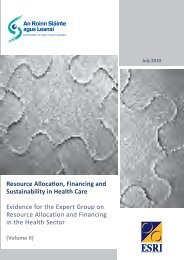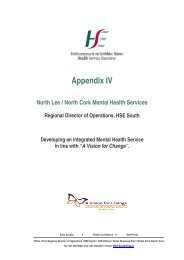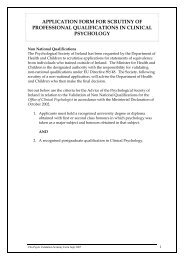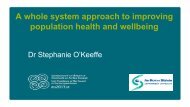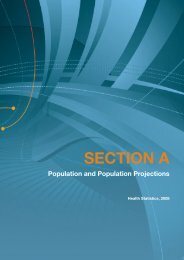Brennan Report - Department of Health and Children
Brennan Report - Department of Health and Children
Brennan Report - Department of Health and Children
You also want an ePaper? Increase the reach of your titles
YUMPU automatically turns print PDFs into web optimized ePapers that Google loves.
Chapter 2 Overview <strong>and</strong> IssuesProblem 6: Inadequate Records/VouchingThe starkest example <strong>of</strong> the absence <strong>of</strong> control under this heading arises in the General MedicalService (GMS).The Comptroller <strong>and</strong> Auditor General reported significant numbers <strong>of</strong> duplicateregistrations for medical cards <strong>and</strong> also significant numbers <strong>of</strong> medical card holders without apharmacy claim for some time (suggesting that they may, for whatever reason, no longer be cardholders) but for whom capitation fees continued to be paid to General Practitioners.Table 2.11: Examples <strong>of</strong> Inadequate Records in the <strong>Health</strong> ServiceYear Agency Problem Identified1998 Eastern There were deficiencies in documentation supporting certain payments<strong>Health</strong> Boardmade by the Eastern <strong>Health</strong> Board. These included:● Grants to Voluntary Bodies: The absence <strong>of</strong> completed applicationforms, evidence <strong>of</strong> grant approval, tax clearance certificates etc.● Home Help Vouching: In one location payment substantiation was notcountersigned, weekly hours not totalled <strong>and</strong> there was an absence <strong>of</strong>how actual payments were calculated (spend c. ¤ 612,000 in this area).● Inter Account Transfers: No supporting explanation for transfers.● Debtor Balance Substantiation: Documentation unavailable tosubstantiate a debtor <strong>of</strong> c. ¤ 464,000 <strong>and</strong> its related bad debt provision<strong>of</strong> ¤ 348,000. (C&AG Annual <strong>Report</strong> 1998)2001 GMS The General Medical Service had advised that there were a potential 8,000duplicate medical card registrations <strong>and</strong> a further 28,000 people with no2.8 CONCLUSIONWe believe that the problems cited above show an inescapable need for fundamental reform inthe financial management <strong>and</strong> control systems within the health service. We are not in thebusiness <strong>of</strong> apportioning blame for what has happened in the past but we consider it ourfunction to make the case for change. What these examples show is that financial managementmust improve further to urgently address the issue <strong>of</strong> accountability within the system. It is notin the interests <strong>of</strong> anyone (service user, taxpayer, health pr<strong>of</strong>essional, service provider orGovernment) to see this continue. We believe the case for reform is compelling.To do this, we must address, as a matter <strong>of</strong> priority, the two major structural weaknesses within the health service that give rise to these specific problems. Specifically, we have identifiedthese as:●●No single institution or person is responsible for the day-to-day management <strong>of</strong> theservice as an integrated national entity; management <strong>and</strong> control is too fragmented.The absence <strong>of</strong> clear accountability for relating clinical <strong>and</strong> other budgets to outputs.If these core structural weaknesses are not adequately addressed then the prospects <strong>of</strong>successfully putting in place practical <strong>and</strong> sustainable financial management systems aresubstantially reduced.39



